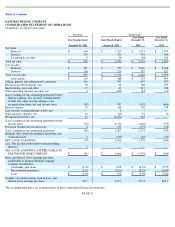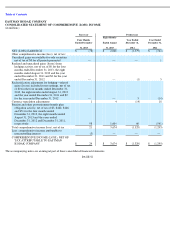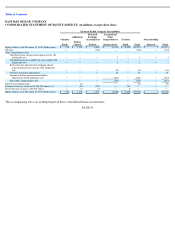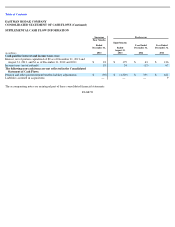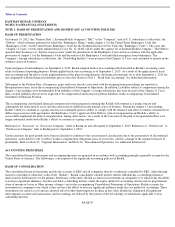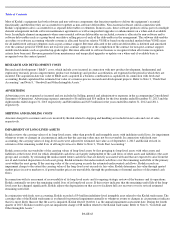Kodak 2013 Annual Report Download - page 64
Download and view the complete annual report
Please find page 64 of the 2013 Kodak annual report below. You can navigate through the pages in the report by either clicking on the pages listed below, or by using the keyword search tool below to find specific information within the annual report.
Table of Contents
Effective August 31, 2013, Kodak sold certain utilities and related facilities and entered into utilities supply and servicing arrangements with
RED-Rochester, LLC (“RED”), a variable interest entity (“VIE”). Kodak determined that it was the primary beneficiary of the VIE. Therefore,
Kodak consolidates RED’s assets, liabilities and results of operations. Consolidated assets and liabilities of RED are $85 million and $3
million, respectively, as of December 31, 2013. RED’s equity in those net assets as of December 31, 2013 is $18 million. The results of
operations and cash flows of RED are immaterial to Kodak. RED’s results of operations are reflected in net income attributable to
noncontrolling interest in the accompanying Consolidated Statement of Operations.
USE OF ESTIMATES
The preparation of financial statements in conformity with accounting principles generally accepted in the United States of America requires
management to make estimates and assumptions that affect the reported amounts of assets and liabilities and disclosure of commitments and
contingencies at year end, and the reported amounts of revenues and expenses during the reporting periods presented. Actual results could
differ from these estimates.
FOREIGN CURRENCY
For most subsidiaries and branches outside the U.S., the local currency is the functional currency. The financial statements of these subsidiaries
and branches are translated into U.S. dollars as follows: assets and liabilities at year-end exchange rates; income, expenses and cash flows at
average exchange rates; and shareholders’ equity at historical exchange rates. For those subsidiaries for which the local currency is the
functional currency, the resulting translation adjustment is recorded as a component of Accumulated other comprehensive (loss) income in the
accompanying Consolidated Statement of Financial Position. Translation adjustments related to investments that are permanent in nature are
not tax-effected.
For certain other subsidiaries and branches outside the U.S., operations are conducted primarily in U.S. dollars, which is therefore the
functional currency. Monetary assets and liabilities of these foreign subsidiaries and branches, which are recorded in local currency, are
remeasured at year-end exchange rates, while the related revenue, expense, and gain and loss accounts, which are recorded in local currency,
are remeasured at average exchange rates. Non-
monetary assets and liabilities, and the related revenue, expense, and gain and loss accounts, are
remeasured at historical rates. Adjustments that result from the remeasurement of the assets and liabilities of these subsidiaries are included in
Net (loss) earnings in the accompanying Consolidated Statement of Operations.
The effects of foreign currency transactions, including related hedging activities, are included in Other income (charges), net, in the
accompanying Consolidated Statement of Operations.
CONCENTRATION OF CREDIT RISK
Financial instruments that potentially subject Kodak to significant concentrations of credit risk consist principally of cash and cash equivalents,
receivables, and derivative instruments. Kodak places its cash and cash equivalents with high-quality financial institutions and limits the
amount of credit exposure to any one institution. With respect to receivables, such receivables arise from sales to numerous customers in a
variety of industries, markets, and geographies around the world. Receivables arising from these sales are generally not collateralized. Kodak
performs ongoing credit evaluations of its customers’ financial conditions, and maintains reserves for potential credit losses and such losses, in
the aggregate, have not exceeded management’s expectations. Counterparties to the derivative instrument contracts are major financial
institutions. Kodak has not experienced non-performance by any of its derivative instruments counterparties.
DERIVATIVE FINANCIAL INSTRUMENTS
All derivative instruments are recognized as either assets or liabilities and are measured at fair value. Kodak does not use derivatives for trading
or other speculative purposes. See Note 14, “Financial Instruments.”
CASH EQUIVALENTS
All highly liquid investments with a remaining maturity of three months or less at date of purchase are considered to be cash equivalents.
INVENTORIES
Inventories are stated at the lower of cost or market with the exception of inventory that was on hand as of the application of fresh start
accounting. The cost of all of Kodak’s inventories is determined by either the “first in, first out” (“FIFO”) or average cost method, which
approximates current cost. Kodak provides inventory reserves for excess, obsolete or slow-moving inventory based on changes in customer
demand, technology developments or other economic factors. In connection with fresh start accounting, Kodak adjusted the net book value of
inventories to their estimated fair value as of September 1, 2013. Refer to Note 3, “Fresh Start Accounting.”
PAGE 60


